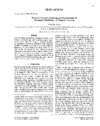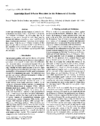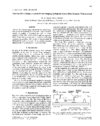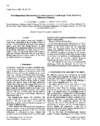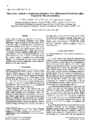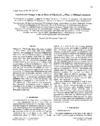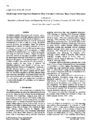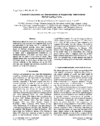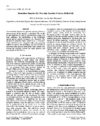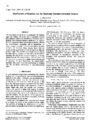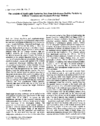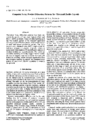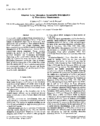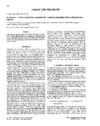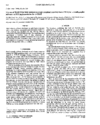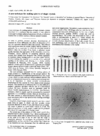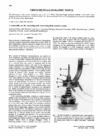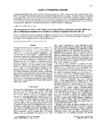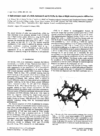issue contents
April 1996 issue

Cover illustration: Neutron scattering pattern in the (hk0) reciprocal-lattice plane from alpha-AgI at 520 K. The portion shown extends from 0 to 5.4 reciprocal-lattice units in both h and k. Courtesy of D. A. Keen, V. M. Nield and R. L. McGreevy.
lead articles
A basic theory and recent experiments of magnetic Compton scattering using synchrotron radiation are reviewed.
research papers
The current practice of restraining all B factors equal to their bonded neighbors is reviewed. A restraint is proposed that uses the patterns of B factors of low-resolution refinements.
A method is described of digitizing an X-ray film image by the use of a charge-coupled device. The use of an analytic representation of the observed film response is demonstrated.
The origins of distortions of diffraction patterns recorded on image-plate detectors are analyzed, and two methods for two-dimensional desmearing are proposed and discussed.
Microtexture analysis of a lithographically prepared alloy sample (LIGA process) has been performed with a 7 μm synchrotron-radiation beam.
X-ray examination of c-axis oriented thin films of YBa2Cu3- O7−δ on various substrates revealed changes induced by oxidation/reduction, doping with Fe and irradiation with heavy ions. The rotation effects originate in changes of the YBCO film microstructure and do not correlate with the substrate type used.
A scattering function is obtained that describes mass-fractal scattering over a wide range of angle in terms of the radius of gyration, contrast factor and fractal dimension. Applications to organic polymer blends as well as low-density ceramics and organic materials are also discussed.
The melt-textured growth process under a magnetic field of Bi2Sr2Ca0.8Dy0.2Cu2O8−y ceramics has been studied. The chemical composition of the different microstructural features has been put into evidence, and correlated with the mechanism of formation.
Two methods to calculate the resolution function for two-axis specular neutron reflectivity are presented and compared with measured reflectivity curves of a well defined sample with pronounced oscillations.
The X-ray method for determination of the additional CuO atomic layer density in the AB2Cu3O7 structure and local changes of interplanar distances is described.
Distributions of rotation axes corresponding to the smallest rotation angles for symmetric objects (crystallites) are given. All proper symmetries in three-dimensional space are considered. A uniform orientation distribution of objects is assumed.
Both the indirect transform and maximum-entropy methods are developed for recovering the length distribution of polydisperse rods from their small-angle scattering data.
Theoretical X-ray diffraction patterns have been calculated for powders of very small faujasite and ZSM-5 crystallites. These calculated patterns give the first realistic picture of the expected appearance of X-ray powder diffraction patterns of ultrasmall crystals of these well known commercial zeolites.
A method is discussed to determine both qualitatively and quantitatively the polarization dependent X-ray absorption due to anisotropic anomalous scattering from fluorescence measurements.
computer programs
Following the method proposed by Marín & Diéguez [J. Appl. Cryst. (1995). 28, 889–840], an algorithm has been developed for the complete simulation of any X-ray back-reflection Laue pattern.
A graphical user interface for X-PLOR has been developed so that users can interact with the program via World Wide Web browsers.
laboratory notes
An airtight 15 ml pressure reaction tube has been modified to hold a mounted crystal. Firmly packed in foam rubber, these crystal shipping tubes have been successfully used to ship macromolecular crystals by overnight courier.
A new technique for making spheres of single crystals is briefly described. It is confirmed that this method is very effective when used to prepare spherical specimens of LaB6, a refractory material that is widely used as a thermo-radiated material.
cryocrystallography papers
A simple device for the transfer of a flash-cooled crystal from the goniometer head, where it is positioned in the cold gas stream, to the storage dewar and vice versa is described.
fast communications
A Monte Carlo technique has been successfully applied to solve the crystal structure of p-methoxybenzoic acid from X-ray powder diffraction data
A high-pressure study of ∊-FeSi, between 0 and 8.5 GPa, by time-of-flight neutron powder diffraction
The crystal structure of cubic iron monosilicide, ∊-FeSi, has been determined at six pressures between 0 and 8.5 GPa by time-of-flight neutron powder diffraction, using the POLARIS diffractometer at the ISIS spallation neutron source.


 journal menu
journal menu









